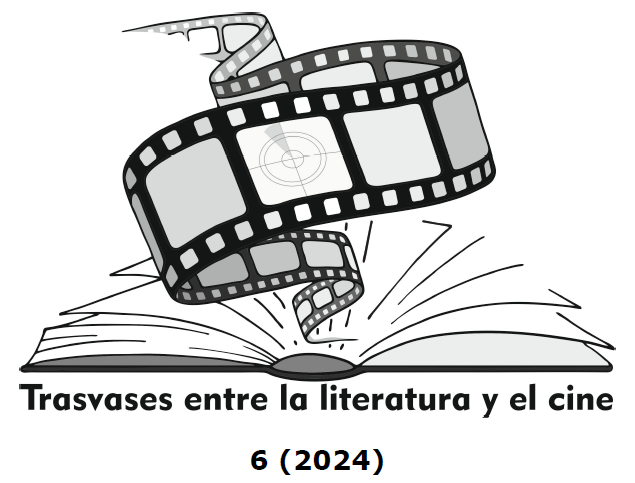Cronenberg (nos) adapta a McLuhan: viendo "Videodrome", leyendo "Understanding Media"
DOI:
https://doi.org/10.24310/tlc.6.2024.19771Palabras clave:
Marshall McLuhan, David Cronenberg, adaptación, los medios, intermedialidad, écfrasisResumen
Este artículo sostiene que Videodrome y la novelización de la película pueden considerarse como una adaptación del análisis de la televisión en Understanding Media. La película de Cronenberg adopta el estilo de pensamiento de McLuhan al convertir su lenguaje figurativo en imágenes cinematográficas; la nove-lización de Martin utiliza la écfrasis para representar el mundo interno del protagonista poseído por la televisión. Expresan, respectiva-mente, la imagen cinematográfica y la descripción verbal de los medios como «las extensiones del hombre». Prestar atención a las formas en que tanto la película como la novela adaptan la escritura de McLuhan, no solo atestigua la naturaleza inter-medial del acto interpretativo, sino que ayuda a delinear los contornos del paisaje mediático contemporáneo.
Descargas
Métricas
Publicación Facts
Perfil de revisores N/D
Información adicional autores
Indexado: {$indexList}
-
Indexado en
- Sociedad Académica/Grupo
- N/D
- Editora:
- Universidad de Málaga
Citas
BILMES, Leonid (2023), Ekphrasis, Memory and Narrative after Proust, London, Bloomsbury Academic.
BOLTER, Jay David (1996), «Ekphrasis, Virtual Reality, and the Future of Writing», in G. Nunberg (ed.), The Future of the Book, Berkeley, University of California Press, pp. 253-273.
BORTZMEYER, Gabriel (2021), «Métastases Médiatiques: David Cronenberg lecteur de Marshall McLuhan», Débordements [Online:
https://debordements.fr/Metastases-mediatiques/. Accessed 31/1/2024].
BROWNING, Mark (2007), David Cronenberg: Author or Film-maker?, Bristol, Intellect Books.
CLÜVER, Claus (2017), «Ekphrasis and Adaptation», in T. Leitch (ed.), The Oxford Handbook of Adaptation Studies, Oxford, Oxford University Press, pp. 459-477.
DEBORD, Guy (2005), Society of the Spectacle, trans. by K. Knabb, London, Aldgate Press.
GENETTE, Gérard (1997), Palimpsests. Literature in the Second Degree, trans. by C. Newman and C. Doubinsky, Lincoln, University of Nebraska Press.
GONZÁLES-FIERRO SANTOS, José Manuel (1999), David Cronenberg. La estética de la carne, Madrid, Nuer Ediciones.
GOROSTIZA, Jorge and Ana PÉREZ (2003), David Cronenberg, Madrid, Catédra.
GRÜNBERG, Serge (2006), David Cronenberg: Interviews with Serge Grünberg, London, Plexus.
LEITCH, Thomas (2012), «Adaptation and Intertextuality, or, What isn’t an Adaptation, and What Does it Matter?», in D. Cartmell (ed.), A Companion to Literature, Film, and Adaptation, Chichester, Wiley-Blackwell, pp. 87-105.
LOUVEL, Liliane (2018), «Types of Ekphrasis: An Attempt at Classification», Poetics Today, 39/2, pp. 245-263.
LUCAS, Tim (2010), «Medium Cruel: Reflections on Videodrome», Criterion [Online: https://www.criterion.com/current/posts/676-medium-cruel-reflections-on-videodrome. Accessed: 8/2/2024].
LUCAS, Tim (2008), Videodrome: Studies in the Horror Film, Lakewood, Centipede Press.
LUCAS, Tim (1984), «Videodrome: Filming One of the Genre’s Most Original and Cerebral Stories in Years», Cinefantastique 14/2, pp. 32-49.
MARTIN, Jack (1983), Videodrome, New York, Zebra Books.
MCLUHAN, Marshall and Quentin FIORE (2008), The Medium is the Massage, London, Penguin Books.
MCLUHAN, Marshall (2009), «The Playboy Interview», Playboy Magazine 03.1969 [Online: https://nextnature.net/story/2009/the-playboy-interview-marshall-mcluhan. Accessed: 20/3/2024].
MCLUHAN, Marshall (2001), Understanding Media: The Extensions of Man, Abingdon, Routledge.
RODLEY, Chris (1992), Cronenberg on Cronenberg, Toronto, Alfred A. Knopf Canada.
PEARSON, Brook W.R. (2012), «Re(ct)ifying Empty Speech: Cronenberg and the Problem of the First Person», in Simon Riches (ed.), The Philosophy of David Cronenberg, Kentucky, The University Press of Kentucky, pp. 155-175.
RIPATRAZONE, Nick (2017), «The Video Word Made Flesh: Videodrome and Marshall McLuhan», The Millions [Online: https://themillions.com/2017/04/the-video-word-made-flesh-videodrome-and-marshall-mcluhan.html. Accessed: 16/2/2024].
RUBERG, Sarah and Jacob WARD (2023), «From brain waves, this AI can sketch what you’re picturing», NBC News [Online: https://www.nbcnews.com/tech/tech-news/brain-waves-ai-can-sketch-picturing-rcna76096. Accessed: 20/3/2024].
RUSSO, Eduardo (2017), «David Cronenberg y el cuerpo: medio y dispositivo en Videodrome y eXistenZ», diCom [Online: https://maestriadicom.org/articulos/david-cronenberg-y-el-cuerpo-medio-y-dispositivo-en-videodrome-y-existenz/. Accessed: 15/2/2024].
SANDERS, Julie (2016), Adaptation and Appropriation, Abingdon, Routledge.
SHAVIRO, Steven (2006), The Cinematic Body, Minneapolis, University of Minnesota Press.
STAM, Robert (2000), «Beyond Fidelity: The Dialogics of Adaptation», in James Naremore (ed.), Film Adaptation, New Jersey, Rutgers University Press, pp. 54-76.
WEBB, Ruth (2016), Ekphrasis, Imagination and Persuasion in Ancient Rhetorical Theory and Practice, Abingdon, Routledge.
Publicado
Cómo citar
Licencia
Derechos de autor 2024 Leonid Bilmes

Esta obra está bajo una licencia internacional Creative Commons Atribución-NoComercial-CompartirIgual 4.0.
Aquellos autores/as que tengan publicaciones con esta revista, aceptan los términos siguientes:
- Los autores/as conservarán sus derechos de autor y garantizarán a la revista el derecho de primera publicación de su obra, el cuál estará simultáneamente sujeto a una licencia Creative Commons Reconocimento-NoComercia-Compartirigual 4.0 cuyo texto completo puede consultar en <http://creativecommons.org/licenses/by-nc-sa/4.0>
- Los autores/as podrán adoptar otros acuerdos de licencia no exclusiva de distribución de la versión de la obra publicada (p. ej.: depositarla en un archivo telemático institucional o publicarla en un volumen monográfico) siempre que se indique la publicación inicial en esta revista.
- Se permite y recomienda a los autores/as difundir su obra a través de Internet (p. ej.: en archivos telemáticos institucionales o en su página web), lo cual puede producir intercambios interesantes y aumentar las citas de la obra publicada. (Véase El efecto del acceso abierto).
Es responsabilidad de los autores/as obtener los permisos necesarios de las imágenes que están sujetas a derechos de autor.
Esta revista electrónica está editada por la Editorial de la Universidad de Málaga (UmaEditorial), siendo necesario citar la procedencia en cualquier reproducción parcial o total.








22.png)











